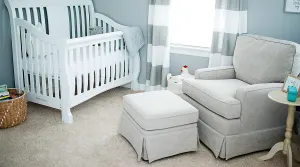Trainer Reveals the Baby Carrying Mistakes That Might Be Hurting You
If you’ve ever tried to fold laundry, eat a snack or just walk across the room without a baby glued to your side, you know the term “velcro baby” is all too real. Parents can easily spend hours each day carrying their little ones—often in positions that strain muscles and stress joints without even realizing it. Over time, those awkward angles and one-sided holds can add up to serious pain.
Strength and Conditioning Specialist Glory Stauss (@glorystauss) is here to help. In a now-viral video, she’s breaking down the most common baby-holding habits that could be hurting your body—and offering three simple corrections that will help you feel better.
The Habit: Popping the hip
You’ve got a baby on your hip, one hand free, and a million things to do—it’s a go-to move for tired arms and multitasking parents. But this posture, where your hip juts out to one side for balance, puts uneven pressure on your pelvis and lower back. Over time, it can lead to muscle imbalances, joint pain, and even sciatic nerve issues.
The Fix: Shift that hip back into alignment and hold baby up higher
Draw your hip back under your torso and try to carry baby a bit higher on your body to avoid leaning into your hip for support. This keeps your pelvis neutral and your core activated, helping reduce strain.
The Habit: Hip shifting
From nap transfers to long bounce sessions, holding baby for extended periods can lead you to shift weight from one leg to the other to find relief. The problem? This side-to-side movement throws off your alignment and forces your muscles and joints to compensate unevenly—especially in your knees, hips and lower back.
The Fix: Keep your hips stacked
Try to keep your joints “stacked”—ankles under knees, knees under hips, hips under ribs. Instead of sinking into one side, take small steps or shift your feet to stay centered and supported.
The Habit: Butt clench or hunch back
When you’re trying to stay upright with a squirmy or fussy baby, you might unconsciously clench your glutes or round your shoulders forward. These instincts are your body’s way of bracing—but they create tension in the wrong places. Chronic clenching can mess with pelvic floor function, while hunching stresses your neck and upper back.
The Fix: Shift hips back, bend knees, extend upper spine
Release your glutes, soften your knees, and shift your hips back slightly. Then, lift through your chest and lengthen your spine. This posture allows your core and back to do the work, keeping you supported without unnecessary tension.
Whether you’re rocking your little one to sleep or carrying a toddler on your hip through the airport, how you hold your baby matters—for both of you. These small shifts in posture may not feel like much at first, but they can make a big impact on your long-term comfort and strength.
Please note: The Bump and the materials and information it contains are not intended to, and do not constitute, medical or other health advice or diagnosis and should not be used as such. You should always consult with a qualified physician or health professional about your specific circumstances.
Navigate forward to interact with the calendar and select a date. Press the question mark key to get the keyboard shortcuts for changing dates.
Advertisement
Advertisement





















































